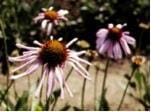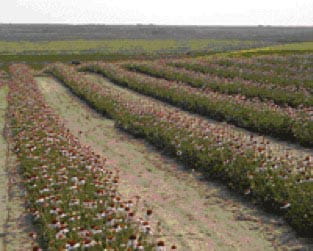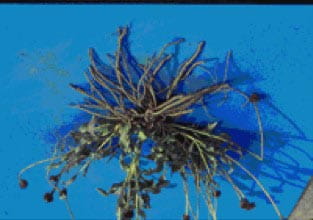
Echinacea, a native wildflower of Manitoba and south-eastern Saskatchewan, as well as the USA, is grown as a medicinal herb in North America, and is grown commercially in many parts of the world.
In North America, the largest acreages have been devoted to Echinacea purpurea, Purple Coneflower, which is native to the USA. Our native species, the Narrow-leaf Coneflower, is hardier and appears better suited to production in Saskatchewan.
For many years it was known as Echinacea angustifolia, and was considered a separate species from the Pale Coneflower, Echinacea pallida. Recent research in British Columbia has suggested that it should be considered a variety of the latter. Consequently, new publications may list our native coneflower as Echinacea pallida var. angustifolia.
Echinacea in Saskatchewan
Under Saskatchewan conditions, Echinacea purpurea appears to be more susceptible to winterkill and aster-yellows disease than our native species, and it is rarely grown here, although some improved cultivars may be grown in gardens as an ornamental plant.
Echinacea is an herbaceous perennial belonging to the Aster or Composite family. For medicinal purposes, it is primarily the root that is harvested, although there may be a small market for foliage, and seed for propagation. The plant was well known by Indigenous tribes for medicinal uses, and had some popularity in the early 20th century, but it gradually fell into disuse once pharmaceutical products became widely available. Now, with a trend towards alternative medicines, Echinacea is popular again.
In the past, it was used for treating sore throats, coughs, septic infections, mouth sores, toothache, snakebite, wounds and insect stings. Today, it is being recognized for its immunostimulant properties in treating colds and flu, and for its anti-microbial properties, including treatment for Candidiasis, skin infections and Herpes simplex virus.
Manufacturers often use echinacosides levels as a standard of quality for Echinacea, but it is now known that Echinacea has multiple-active compounds. In our native plant, the polyphenolic compound called Cynarin is found in young roots and can be used as an authenticity test, as it is found only in E. pallida var. angustifolia and E. pallida var. tennesseensis (formerly E. tennesseensis), but not in E. purpurea or other varieties of E. pallida.
Echinacea is found marketed as a pure product or in combination with other herbal products, such as goldenseal.
Echinacea is a bristly-hairy plant, growing from 15-50 cm in height, with greatest height being achieved under cultivation, and when the plant is more than one year old. The leaves are lance shaped or linear-lanceolate, and most numerous at the base of the plant. Flowers are daisy-like, with pale to deep purple ray florets surrounding a central cone which produces yellow pollen. The flowers tend to fade with age.
Distinguishing characteristics of our native species are involucral bracts (beneath the flower head) that are more than two cm wide, ray florets less than four cm long, and high levels of Cynarin in young roots. Hybrids are known to occur, and in the mid 1990s there were commercial mix-ups in species names. Consequently there may still be Echinacea being grown which is not true-to-variety or to species. Today, buyers may insist on a certificate of authenticity before purchasing Echinacea. In Canada, some of what has been offered as E. angustifolia (now E. pallida var. angustifolia) may in fact be E. pallida var. pallida, (formerly just called E. pallida), a type found in Eastern North America, or hybrids of the two.
Potential growers should carefully assess the market before growing Echinacea on a large scale. As the crop is not normally harvested for two to three years, markets can change, as can prices. In the late 1990s and early 21st century, there was a glut of Echinacea on the market, particularly in the USA, but by 2002 demand began to increase.
Propagation
Echinacea is grown from seed, but commercial greenhouses may offer young transplants, commonly referred to as plugs. Regardless of source, both seed and plugs should be certified as authentic. Germination can be erratic, and sometimes very poor (as low as 15 per cent) unless the seed has been stratified or subjected to winter conditions or chemically-treated.
Good results have been achieved in some areas with fall (October) sowing of seed, which eliminates the need for stratification or other treatments. This method may work best where wind shelter and good snow cover is likely.
If spring seeding in a greenhouse is to be done, the seed may be disinfected with a 10 per cent bleach solution for five minutes, rinsed four or five times, soaked for 24 hours in room temperature water which is changed two or three times and kept lit at night, then treated with ethephon (Ethrel®) at a rate of one ml/litre, for two hours, to assist germination.
Some growers have successfully used ethylene fumes from ripening apples to achieve the same purpose as ethephon, but it is not practical for large lots of seed. After drying the seed, it is planted shallowly in plug trays, as it benefits from light for germination. The growing media must be kept moist. Misting to keep humidity high is desirable, and an air temperature of 22°C, along with overhead lighting, is desirable.
Research has indicated that seedlings are quite tolerant of root injury during transplanting indoors, but not to drought stress when young. It is important to avoid allowing seedlings to become rootbound before transplanting to the field, and some irrigation at planting time may be desirable. Deep plug trays, such as 128 cell packs are preferred.
Direct seeding in the field is possible, but if fields are not well prepared and relatively weed free, the use of plastic mulch may be advisable. In this case, the plastic is laid down (mechanically) and holes are punched in the plastic where plants are desired, and seeded, or transplants are used.
Organic growers should check with their certifying agency regarding the use of plastic mulches. If no mulch is used, growers should be prepared for much hand-weeding or the plants may quickly be overgrown by weeds and the crop lost.
Fall transplanting is not recommended. Even if the plants survive the winter, the crown may be injured, causing the plant to regenerate from lower roots, causing delayed emergence and poor growth. An alternative method of growing Echinacea transplants is to grow them during summer or fall and overwinter them in a straw-covered pit. The young plants can be then transplanted in spring.
Field location
Because Echinacea is primarily a root crop, heavy clay soils should be avoided, as digging and cleaning roots is much more difficult in these soils. In addition, there is more likelihood of the crop encountering root rots in poorly drained soils. Consequently a lighter loam to sandy loam soil is desirable.
Satisfactory crops have been grown on both level and sloping land in diverse areas of Saskatchewan. In areas where snow cover is not reliable, growers may need to provide straw mulch in winter, otherwise Echinacea seems fairly tolerant to prairie winds once established.
Much of the Echinacea grown in Saskatchewan is produced using organic methods. If organic certification is desired, then a field that is free of herbicide and pesticide residues is mandatory. In any case, a field as weed-free as possible is desired, as Echinacea is not a good weed competitor in its first year.
A full sun location is desired. Some growers have found the incidence of Sclerotinia disease to be high when Echinacea was planted in field that had previously grown canola crops.
Spacing in the field

The ideal field density of Echinacea has been controversial, ranging from 15,000 to 55,000 plants per acre. Some commercial sellers of Echinacea plugs have advocated much higher planting rates. Row spacings of about 61 cm and in-row spacings of 15 cm (about 45,000 plants/acre) have given good yields in research trials at Outlook, SK. Growers using plastic mulch often use a double staggered row of plants. Where direct seeding is used, a density of up to 120 seeds/m2 has been satisfactory.
Transplanting to the field should take place in May or June, before the onset of hot weather. The transplanting can be done by hand, or with a vegetable transplanter. Plugs should be at least 10 weeks of age.
Soil fertility
Ideally, soil organic matter should be in the range of three to five per cent. Nutrient requirements are best determined by annual soil tests. In general, the application of 100 kg N/ha and 50 kg/ha of P205 may be desirable. Potash (up to 225 kg/ha), sulphur (22-33kg/ha) and iron (8-10 ppm) may also be desirable. Organic growers will need to look for fertilizers that are approved by their certifying agency.Growing the crop
During the summer months, weed control is critical during the first year. Clean cultivation between rows is desirable, with hand weeding within the row as necessary. Grass or green cover crops between rows may harbour leafhoppers which can spread aster yellows disease to Echinacea. Some organic growers have used cayenne sprays in attempts to repel leafhoppers.
Aster yellows disease is more likely to be recognized in second or third year crops. Symptoms include yellowing or reddish-tinged foliage, stunting, and abnormal flowering, with flowers becoming malformed, and losing their purple pigment. There may be excessive proliferation of shoots in advanced stages.
The incidence of the disease can vary from year to year, depending on the amount of disease-carrying leafhoppers in the area. These leafhoppers are often blown in on winds from the USA, but it is now known that some leafhoppers can overwinter in Saskatchewan.
Plants infected in their first year will show symptoms the following year, although if the plants become infected early in the season, they may be sufficiently weakened that they succumb to winter or other diseases. Once plants are infected they need to be discarded. If the infection occurs late in the year on two or three year old plants, some roots might be salvageable. Most growers routinely inspect their crops weekly for infected plants and remove them when found.
In the early stages the symptoms may be confused with nutrient deficiencies, particularly iron and magnesium. If only one plant is infected in the area, it is more likely to be the result of aster yellows disease, as nutrient deficiencies are more likely to be more widespread in the field.
Irrigation is generally not required during the summer months, but in instances of severe drought, some irrigation may be beneficial. Under some conditions irrigation may increase root yield, but it is thought that in the year of harvest some stress may be desirable to increase chemical quality of the roots.
Seed collection
Seed for future crops or sale is generally harvested in September or October. The exact timing is determined by the condition of the cones, which should show some indication of shattering. Harvesting too early may give seed which is difficult to remove from cones and have lower viability.
The cones are generally clipped off the flowering stems by hand and gathered. The seed can be separated and cleaned using conventional seed cleaning equipment. It may be possible to harvest the seed with a combine (small plot combines have been used), but there is potential for damaging the seed if the cones are not sufficiently mature.
The market for Echinacea seed was very lucrative in the 1990s but an oversupply has drastically reduced prices.
Harvesting of foliage
Traditionally, foliage of Echinacea purpurea has been marketed rather than that from Echinacea pallida var. angustifolia. While roots of the latter are mainly desired, there may be some limited market for dried foliage as well. This can be collected by mowing the plants in autumn of the second or third year, and allowing the foliage to dry.
Harvesting the roots
Echinacea roots are harvested in the fall after several frosts have occurred, usually in October. Prior to digging the top growth is mowed off and removed. Root harvesting equipment for other crops such as potatoes, carrots or ginseng have been used with some success. Ideally the digger should be capable of digging 60 cm deep and lifting the roots to the surface. The roots are quite brittle and loss of smaller, deeper roots is inevitable, but as many as possible should be gathered, for the chemical content of the smaller roots is often superior. Following digging, the roots are gathered and washed to remove soil in order to provide a clean product and to reduce the incidence of decay in storage. Further trimming and sorting may be desirable.
Prior to drying, a 10 minute dip in a one per cent solution of hydrogen peroxide is desirable to further disinfect the roots.
Drying the roots

Small lots of roots can be air dried in a shaded area or indoors with the use of fans to provide good air circulation. A dryer with a temperature of 30°C is preferred, but care should be taken not to stack the roots too thickly, or to use excessive heat. The roots should be very brittle afterwards, with a moisture content of around 10 per cent. Thick roots which will hold a fingernail imprint require further drying.
The dried product will weigh about 25 per cent of the fresh weight.
Once the roots are dried they should be transferred to a breathable bag such as Mini Bulk Bags, and stored in a frost-free, but cool building that can be kept free of rodents and insects.
Random samples of each bag should be removed and kept for record-keeping and for any laboratory analysis that buyers may request, as well as for samples that buyers may want for visual inspection. Growers should check their stored product periodically for moulding.
Yields
Yields will be dependent on the plant density at harvest time, which will be affected by the planting distances, disease incidence, cultural practices and growing conditions.
Research at Outlook, Saskatchewan has provided some yield data based on direct seeding. Three year old crops yielded between 1200 and 1330 kg/ha (1070 - 1150 lb/ac) dry root under dryland conditions. Yields of around 1450 kg/ha (1300 lb/ac) were achieved using higher seeding rates (120 seeds/m2) and there was little difference between irrigated and dryland cultivation at that seeding rate. Dry root yields of 2400-2700 kg/ha are possible using transplants at a density of 111,200/ha (roughly 45,000/acre; in row spacings of 15 cm).
Quality analysis
Growers should have their product analyzed for echinacoside and total alkylamide content. Most buyers desire a product with an echinacosides content of 1.2-1.5 per cent, a level that has not always been achieved in Saskatchewan. Product that is low in echinacosides may be high in total alkylamide content. Some buyers require a minimum of four per cent total alkylamides.
Depending on the buyer, it may be possible to market Echinacea without chemical analysis, but these buyers may offer lower prices. The University of Saskatchewan, Plant Science Department has laboratory facilities for analyzing Echinacea roots, but other laboratories are available.
Prices
Echinacea prices are generally highest for small lots and lower for large quantities. Organic product may, but not always, receive a higher price.
